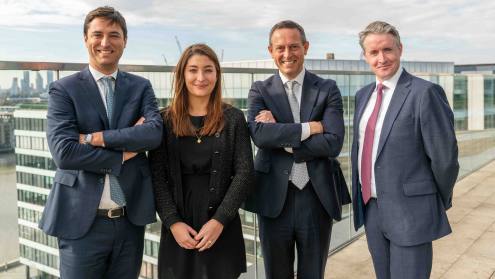This year, the African Development Bank created a new asset class, becoming the first institution of its kind to issue hybrid capital securities. The transaction was in a sustainable bond format and will enhance the bank’s capacity to fund environmental and social projects. BNP Paribas was one of two structuring banks.
Multilateral development banks are being encouraged to find new sources of funding, while being urged to do more to tackle poverty and climate change. With this in mind, the World Bank announced increased collaboration between itself and nine MDBs, including the AfDB, during last year’s IMF meeting in Marrakech, Morocco.
“Their shareholders already have very high debt, so it’s important to optimise the balance sheets of MDBs,” says Fred Zorzi, BNP Paribas’ global head of primary markets. “They can do that by using [significant risk transfer, a form of synthetic securitisation], or by using hybrids.”
Their shareholders already have very high debt, so it’s important to optimise the balance sheets of MDBs
While the AfDB is the first MDB to issue hybrid bonds, Finland’s Municipality Finance (also known as MuniFin) laid down a marker for the public sector as a whole back in 2015. With BNP Paribas as sole structuring advisor, the Finnish local government financing agency launched a €350mn bond deal that qualified as Additional Tier 1 under European Banking Authority regulations.
Structured as a perpetual non-call 6.5 year instrument, the MuniFin bond received equity credit from S&P Global Ratings. It had the lowest coupon offered in this format and was the highest-rated AT1 in the market.
Original concept
The AfDB started thinking seriously about a hybrid issue in 2020. “The rationale was to defend its AAA rating, which is central to its business model,” explains Gilles Renaudière, BNP Paribas head of capital structuring, Emea. “As we moved into Covid, there was concern that any downgrade in the ratings of its sovereign shareholders could affect the AfDB.”
That risk has prompted many MDBs to take a closer look at hybrids. Once the AfDB had decided to go down this route, it faced two challenges, according to Ben de Forton of BNP Paribas’ sovereign, supranational and agency debt capital markets unit. “The first was the structuring of the instrument,” de Forton says. “The second was creating and launching a transaction for which there was no real comparable in the market.”
The motive behind hybrid issuance was to extend the institution’s balance sheet without forfeiting any of its top-flight credit rating. That depended on getting 100 per cent equity treatment from the rating agencies.
The agencies had established routines for evaluating hybrids from traditional banks and from corporates. “But they had no methodology for MDBs,” Renaudière points out. In 2020, he says, S&P had only three lines in its standard methodology on what to look for if an MDB issued hybrids.
“It mentioned the ability to absorb losses as a going concern, but that can be an expensive feature,” he says, adding that hybrid issuance is very price-sensitive. “If it’s too expensive, it becomes counterproductive and you can’t deploy it.”
BNP Paribas and co-structuring bank Goldman Sachs got down to creating a structure that worked for the rating agencies. They had to present their ideas to each agency separately, on a green-light or red-light basis. “The agencies don’t give advice,” Renaudière says.
In the process, S&P created a whole new methodology for MDB hybrids, while Moody’s and Fitch fine-tuned their existing regimes. All the players knew they were crafting a new asset class and nothing happened in a hurry.
Equity-like asset
Three principal features make a bond more equity-like. It should be undated, or perpetual. The issuer should have optionality over distribution payments which, if skipped, should be non-cumulative. And it should offer a degree of loss absorption while the issuing entity is still a going concern.
The AfDB bond addressed all three in its own way, though essential differences between MDBs and banks or corporates necessitated some compromises. A bank hybrid, for example, absorbs losses at the point of non-viability. MDBs have no deposit base and do not depend on market confidence, so the AfDB instrument works slightly differently.
Its notes are perpetual and subordinated, subject to full permanent principal write-down if a call is made on callable capital. That can only be made if the bank becomes insolvent and is unable to service its debt.
BNP Paribas makes the point that, to date, no MDB has ever called on its callable capital, thanks to “their robust risk management framework, their long-term financial sustainability framework and extraordinary shareholder support”.
Coupon payments are made at the board’s discretion, though under normal circumstances the likelihood of deferral is remote. Mandatory coupon cancellation is triggered when total assets fall below 7.5 times paid-in capital and reserves, and a breach would therefore mean a capital depletion of 50 per cent.
“The principle is that the instrument only absorbs losses at the point where the shareholders must come in and rescue the institution,” says Renaudière. “The risk to investors is not that different to a corporate hybrid, though it is different to a bank.”
Once the key features of the instrument had been settled, all three rating agencies undertook to give it 100 per cent equity credit treatment. It will also count as 100 per cent equity under the .
Customer profile
The next step was to inform and educate likely investors. Several pre-summer meetings were held in June 2023. Then, in September, a three-week series of calls and meetings with both rates and credit investors took place in the US, UK and across continental Europe. The roadshow’s reception was described as “spectacular”, drawing in more than 150 investors across the globe.
“This was all about creating a new product and creating a new investor base, which is why it took so long,” Zorzi says. “Investors have got specific mandates, but we were coming with something that didn’t really fit in.”
Who would the investors turn out to be? While traditional SSA mandates focus on rates products, corporate and bank hybrids are generally bought by investors in credit products. The fact that this was unfamiliar subordinated debt made it harder to park within SSA mandates.
“We ended up very much with credit investors,” says de Forton. Investors who had bought emerging market bank and corporate hybrids in the past were an important focus of attention, as were hedge funds.
“Hedge funds have the most flexible mandates, so they were always one of our key targets,” Zorzi explains.
Volatile market conditions prevented any transaction on the heels of the September roadshow, and the issuer decided to wait for a more supportive execution window. That was finally judged to have opened in the closing days of January 2024, when the AfDB announced a new perpetual non-call 10.5 sustainable hybrid deal in US dollars, expected to be rated AA– by S&P.
After indications of interest in the region of $3bn, books were opened with initial price thoughts of 6.375 per cent area. By the time the books were closed orders had exceeded $6bn. The annual coupon was set at 5.75 per cent and the deal was launched with a size of $750mn.
“The transaction priced 130 basis points back from the level of a dated senior deal,” Zorzi notes. The book attracted 275 investors, twice as many as the AfDB’s largest senior bond deal.
The issuer wanted this to be a sustainable bond. “The format is in line with AfDB’s newly established sustainable bond framework,” says Anusha Agarwal of BNP Paribas DCM solutions capital products and FIG DCM ESG. “It should enable at least $2 of green and social lending for every $1 raised.”
The bankers are not expecting an avalanche of similar issuance from other MDBs, but say that there will be more. “It will be organic,” Zorzi says. “Hybrid is just one of the tools in the tool box.”







